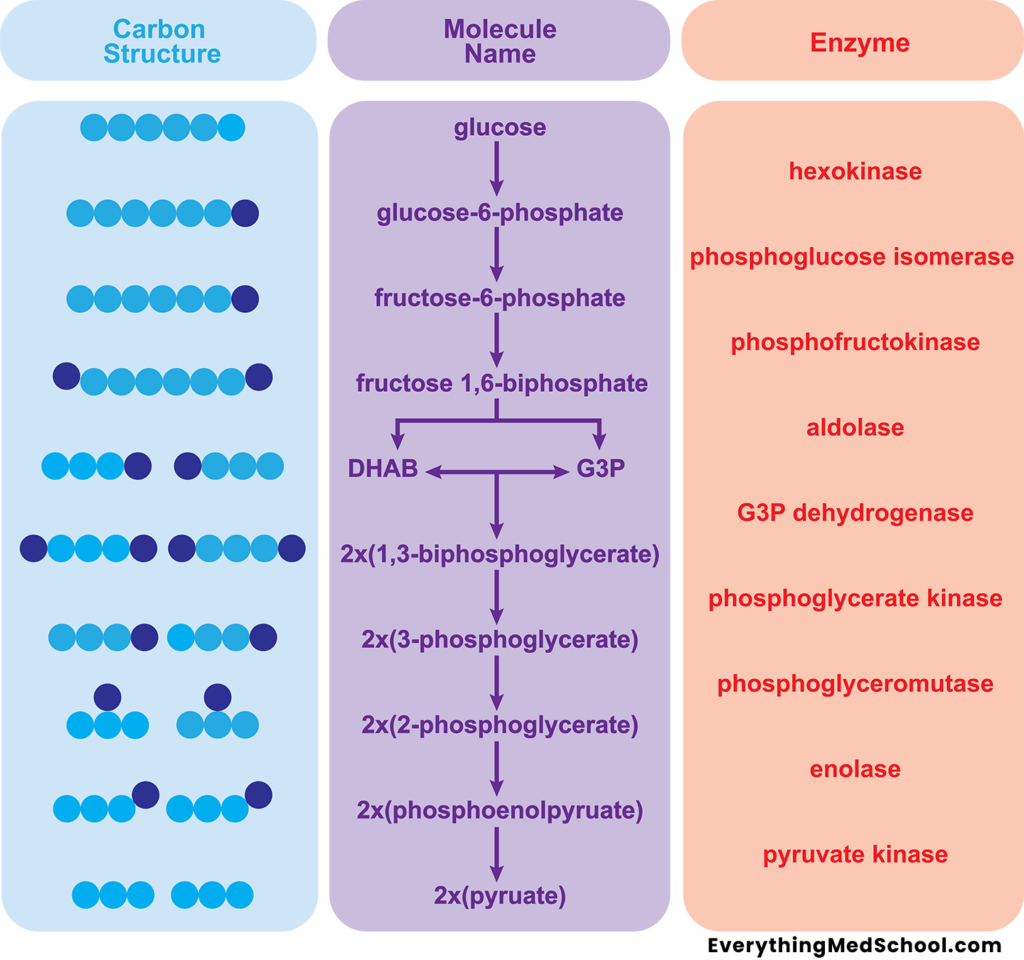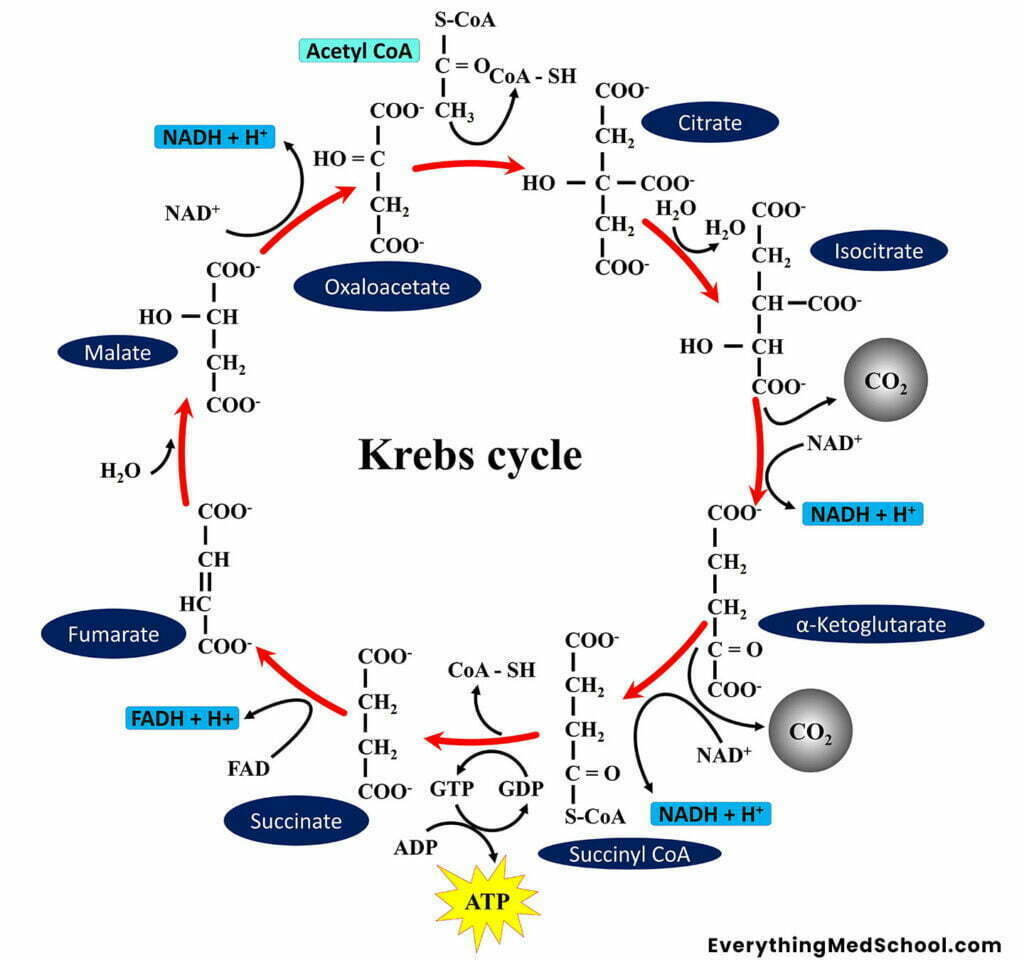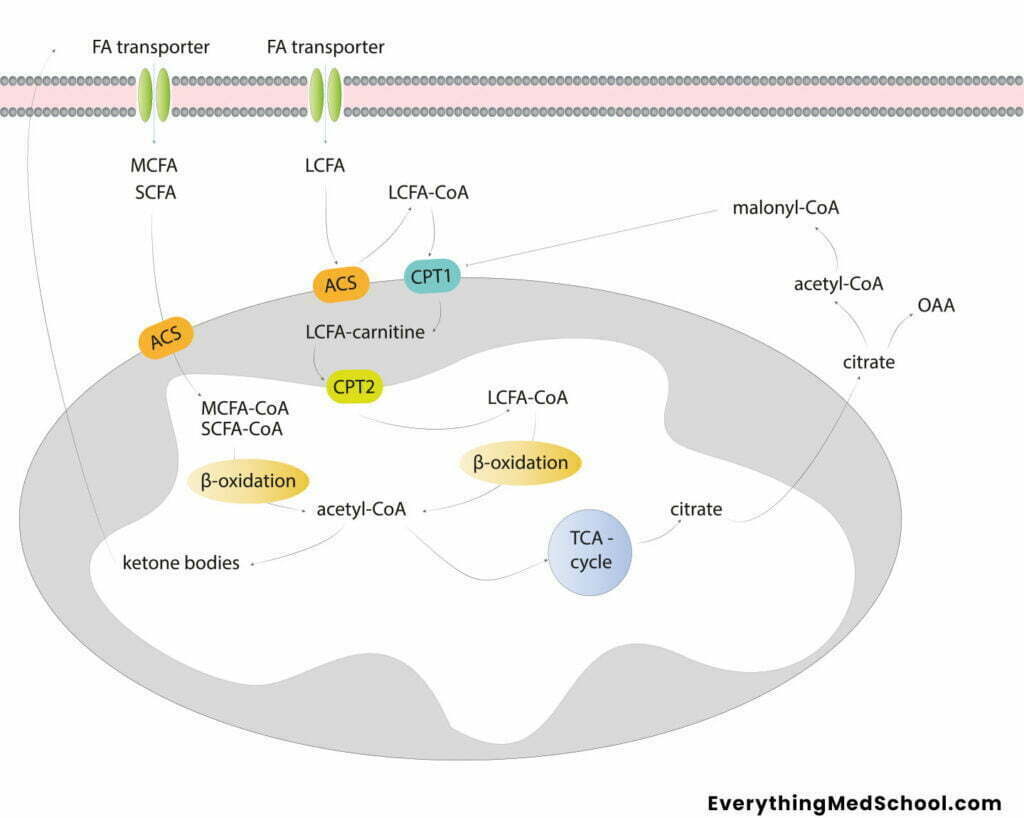The information on this website should not be considered medical advice.
This website contains affiliate links, and we may be compensated for referrals.
When I started medical school, I assumed we left the Krebs cycle behind with the MCAT. However, the biochemistry pathways like the Krebs cycle, glycolysis, pentose phosphate, and beta-oxidation pathway resurface in the first two years of medical school and are testable on the Step 1 exam.
I’ll describe four learning methods to understand these pathways and the best time to use each technique. You may find that one way might work better in one semester or suit your learning style. However, it is common to use multiple methods to layer your understanding and solidify your knowledge.
Regardless of which method you are using, it is crucial to have a “master sheet” containing all the pathways. As all roads lead to Step 1, it’s critical to understand connections between body systems, including biochemistry pathways!
Your time is the highest valued resource in medical school, so I don’t recommend creating your own master sheet because it can take away your learning. I used the biochemistry map from Physeo. First Aid also has a beautiful chart. I would decide on one to return to USMLE Step 1 and beyond.
Method #1: Rote Memorization
This method is memorization by brute force. The best and most eco-friendly way to increase the number of times you test yourself is by grabbing a whiteboard. I found my whiteboard at the dollar store, which was paper-sized and easy to travel between home and school.
I wrote a list of pathways I had trouble with on a post-it. I would rewrite them every day after lunch and again at the end of the day. Another way to increase your exposure to material is to use pre-made decks on Anki or Quizlet.
A quick tip: pay special attention to reactions and enzymes that are rate-limiting, linked to disease, or targetted by drugs.
Choose this method when you are limited in time and your exam is in the next week.
Cons: This method takes time! The process of learning pathways in a step-wise fashion can limit your memory retrieval. It can be hard to remember other parts of the pathways without writing out the whole pathway. This method is not helpful if your exam requires a deeper understanding and includes pathophysiology or multiple organ systems like in M2 or dedicated.
Method #2 Watch and Draw
If you are just starting biochemistry, this is where you should start. While rote memorization can help as a quick fix, there is no way around needing to get to know your pathways.
Like rote memorization, you should get in on the action. Grab your master sheet and annotate the clinical correlations or connections while following along with your video. This strengthens helps establish the master sheet as a visual aid. Some great resources can include paid services like Boards & Beyond and free videos like Ninja Nerds on Youtube.
Choose this method when you’ve just started learning biochemistry pathways and have a couple of weeks before your exam.
Cons: Watching videos and annotating can take time, especially if you need to add repetition. This method can be expensive if you don’t have a Boards & Beyond subscription.
Method #3 Visual Mnemonics
Visual mnemonics are proven tools to improve long-term retention because they add another layer of connection to concepts and often clunk information together. An excellent resource for biochemistry visual mnemonics is Pixorize. Pair this method with spaced repetition like Anki, Quizlet, or pulling up the pictures and testing yourself.
Choose this method when you’ve built some familiarity with the pathways and need to commit concepts to your long-term memory.
Cons: White more connections between concepts are made, they also need to be maintained. This method needs to be paired with repetition to work. This service can also be costly to add another subscription.
Method #4 Word Mnemonics
Many word mnemonics, including acronyms or rhymes, can be found on the internet or in resources like First Aid. Another excellent resource is the Dirty Medicine Youtube channel. Dirty Medicine will go through the pathways, include some high yield clinical correlates, and give a memorable mnemonic towards the end. Include these on your master sheet! I’ve also included some of my favorites below and other high-yield things.
Choose this method when you are a visual learner who either doesn’t have the budget for extra resources or doesn’t like video mnemonics.
Cons: There are many versions for each pathway. Try to pick one so you don’t confuse the memory aids with each other.
Glycolysis & Gluconeogenesis Mnemonics
Goodness Gracious, Father Franklin Didn’t Go Buy Perfect Pumpkin to Prepare Pies
Glucose
Glucose-6-phosphate (G6P)
Fructose-6-phosphate (F6P)
Fructose-1,6-bisphosphate
Dihydroxyacetone phosphate (DAP)
Glyceraldehyde phosphate (GAP)
B = 1,3-bisphosphate
P = 3-phosphoglycerate
P = 2-phosphoglycerate
to
Phosphoenolpyruvate (PEP)
Pyruvate
High-yield
- The irreversible steps and their regulation
- Which steps are different for gluconeogenesis
Citric Acid Cycle / Kreb’s Cycle Mnemonics
High-yield
- Follow the carbons. The Krebs cycle starts with six carbons and ends with four carbon. Where the carbons are lost are the irreversible reactions that release carbon dioxide.
- Every dehydrogenase enzyme results in NADH, except succinate which results in FADH
- There’s an overwhelming amount of mnemonics. Pick one that is memorable to you, and stick with it!
Substrates
- A creative song written by Wilson Lam (Below)
- Citrate Is Kreb’s Starting Substrate For Making Oxaloacetate
Enzymes
- Can Anthony Drink Down Seven Drinks ‘Fore Death
Pentose Phosphate Pathway (HMP Shunt) Mnemonics
High-yield
- Location, location, location (and the connection to other pathways like fatty acid synthesis)
- How it’s connected to oxidative stress homeostasis and G6PD deficiency
My Fancy LiFe AS an Orthopedic Surgeon is cool As FAck
Location – Process involved
Mammary – Fatty Acid synthesis
Liver – Fatty Acid and cholesterol synthesis
Adrenal gland – Steroid synthesis
Ovaries – Steroids synthesis
Adipose Tissue – Fatty Acid synthesis
Beta-Oxidation Mnemonics
High-yield:
- Location of each step in the cell (mitochondria vs. cytoplasm)
- Diseases linked to each enzyme deficiency
FATTY AntioniO! OH Oh, C, what you did now!
FATTY Acid Oxidation
Step 1: Oxidation
Step 2: Hydration
Step 3: Oxidation
Step 4: Cleavage of acetyl CoA
Closing Tips
Regardless of the method you choose, it’s essential to integrate repetition. Information needs rehearsal to achieve long-term memory. One way to get past surface-level retention is to do practice questions in question banks, textbooks, or free resources like Mehlman.
This is essential because the questions later in basic sciences and Step 1 will emphasize the relationships between pathways including hormone influence, how drugs interact, vitamin deficiency interactions, and resulting diseases.
Which method do you use? Share below!
Rainee Khabagnote attends medical school at St. George’s University. She is passionate about health coaching, powerlifting, and spending time with her two puppies.








Facebook Comments